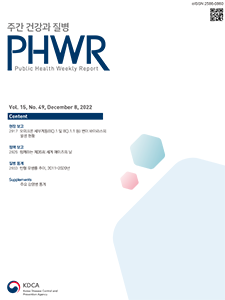Current Issue
Vol.15 No.50, December 15, 2022
-
Original Articles 2022-12-15
 0
0
 3314
3314
 411
411
Analysis of Antibiotic-resistant Gene Characteristics of Drug-resistant Mycobacterium tuberculosis from the Republic of Korea (2020–2021)
Young Mi Kim, Min Ji Lee, Jeong Seob Lee, Dong Hyeok Kim*, Jun Young Kim, Jaeil Yoo
Public Health Weekly Report 2022; 15(50): 2935-2953 https://doi.org/10.56786/PHWR.2022.15.50.2935AbstractDrug-resistant tuberculosis (DR-TB) is one of the major public health challenges owing to its long treatment period and low treatment success rate. For a rapid and accurate diagnosis of drug resistance, many countries are using recently introduced whole genome sequencing (WGS). In this study, a total of 196 DR-TB strains were collected through a contact investigation in a congregate setting between 2020 and 2021, and WGS was conducted. In all, 188 DR-TB strains were identified as rifampin-resistant TB. Mutations in only the rpoB gene were found to be associated with rifampin resistance and mutations in 187 strains were identified in the region determining rifampin resistance, except for in the case of one strain. The most prevalent mutation was rpoB_S450L (100/188, 53.2%). Gene mutations related to isoniazid resistance were identified in 143 strains, and the most prevalent mutations were katG_S315T (107 isolates, 74.8%) and inhA_c-777t (30 strains, 21.0%). Among 36 quinolone-resistant strains, 31 had mutations in the gyrA and gyrB gene regions that determine quinolone resistance. Mutations in codon 94 of gyrA (16/36, 44.4%) were the most frequent. The sensitivity of WGS compared with that of the phenotypic drug susceptibility test for rifampin and isoniazid was 96.6% and 95.9%, respectively. In addition, in silico spoligotyping revealed that 91.5% of the rifampin-resistant strains belonged to the Beijing clade. In conclusion, we found that WGS has excellent potential for application in drug resistance prediction and provides valuable information including strain typing. In the future, it would be necessary to use WGS to analyze the molecular characteristics and distribution status of drug-resistant strains.
-
Surveillance Reports 2022-12-15
 0
0
 1111
1111
 189
189
Monitoring of Chiggers (Scrub Typhus Vector) in the Republic of Korea, 2021
Tae-Kyu Kim, Jung-Won Ju, Hee il Lee*
Public Health Weekly Report 2022; 15(50): 2954-2970 https://doi.org/10.56786/PHWR.2022.15.50.2954 Abstract
AbstractScrub typhus is an acute febrile disease in autumn and is known to be transmitted by chiggers infected with Orientia tsutsugamushi . In order to survey occurrence of chiggers in the Republic of Korea, chiggers were collected weekly at 16 locations nationwide from August 25, 2021, to December 15, 2021. The number of chiggers collected per trap per week was calculated for comparison. The period of increasing of chiggers was delayed by 2 weeks compared to 2020. Moreover, after showing the highest occurrence (week 44), it decreased gradually because of the warmer temperature. Of the total 4,636 chiggers, 4,614 were identified as 16 species in 5 genera. Among them, Leptotrombidium scutellare was the dominant species with 1,207 specimens (26.0%). In 2021, the incidence of scrub typhus (per 100,000 population) was the highest in Jeollanam-do (60.69), and the species composition of L. scutellare was high (70.6%). In addition, after the increase in the occurrence of L. scutellare , the patient incidence increases around the distribution area of the species. Considering these facts, it appears that the occurrence of L. scutellare is closely related to patient incidence. Given the recent aging of the rural population and an increase in the number of people working outdoors, there is a high concern that the number of scrub typhus patients will increase. Therefore, continuous investigation is necessary.
-
Review & Perspective 2022-12-15
 2
2
 2907
2907
 276
276
Introduction to the Antimicrobial Stewardship Program: Its Current Status and Policy Direction in the Republic of Korea
Hwa-Young Lee, So-yeon Ryu, Ga Yeong Jeong, Kyoung-Mi Kang, Hyosoon Yoo*
Public Health Weekly Report 2022; 15(50): 2971-3003 https://doi.org/10.56786/PHWR.2022.15.50.2971 Abstract
AbstractAmid the growing global crisis over antimicrobial resistance, the importance of antimicrobial stewardship program (ASP) is emerging. With this focus, led by the U.S. and Europe, related policies are also being pursued in the Republic of Korea, where the National Action Plan on Antimicrobial Resistance was established in 2016 as the basis for policy and institutional support for medical institutions. From the current policy oriented toward acute hospitals, we will seek related policy measures to gradually expand the ASP to primary and secondary medical institutions, including small and medium-sized care hospitals.
-
QuickStats 2022-12-15
 0
0
 586
586
 88
88
Trends in the Gap in Prevalence of High-Risk Drinking Between Metropolitan Cities During 2012–2021
Public Health Weekly Report 2022; 15(50): 3004-3005 https://doi.org/10.56786/PHWR.2022.15.50.3004

pp. 1433~1461
Most Keyword
?
What is Most Keyword?
- It is the most frequently used keyword in articles in this journal for the past two years.
Most Read
-
Waterborne and Foodborne Disease Outbreaks in the Republic of Korea, 2023
Myung-Jae Hwang, So Yeon Park, Hyungjun Kim, Se Jeong Yang, Sungchan Yang, Jin Seon Yang
Public Health Weekly Report 2025;18: 17-32 https://doi.org/10.56786/PHWR.2025.18.1.2 -
Implementation Plan for the Coronavirus Disease 2019 Vaccination for the 2024–2025 Season: Recommendations of the 6th Expert Committee on Immunization Practices
Hyewook Hwang, Wookeon Lee, Seohyeon Ahn, Young-Sook Choi, Seunghyun Lewis Kwon, Dongwoo Lee, Eun Hwa Choi, SokGoo Lee
Public Health Weekly Report 2025;18: 90-102 https://doi.org/10.56786/PHWR.2025.18.2.3
Editorial Office
+82-43-719-7569





 Full Text
Full Text Cite
Cite


